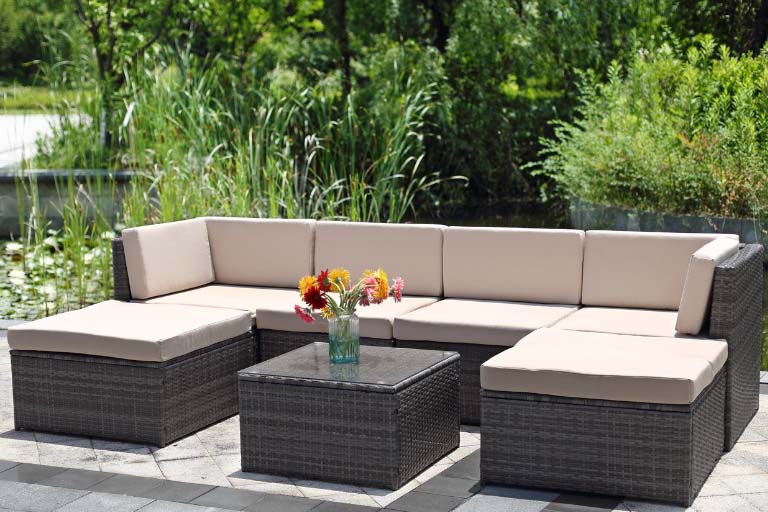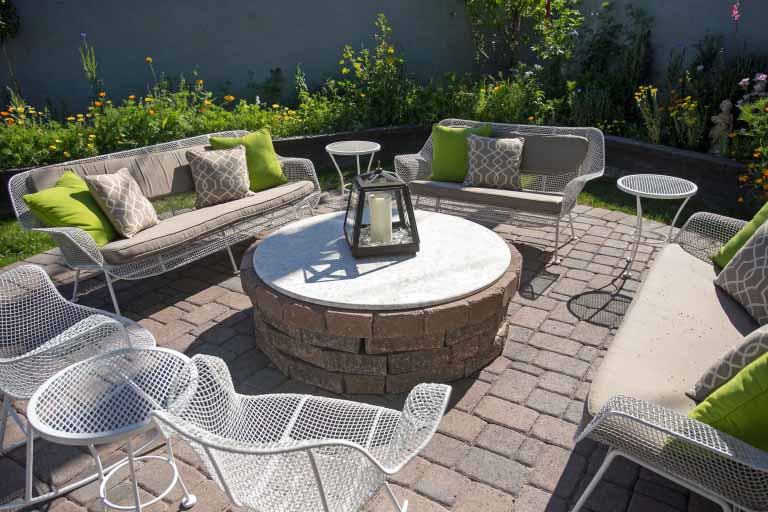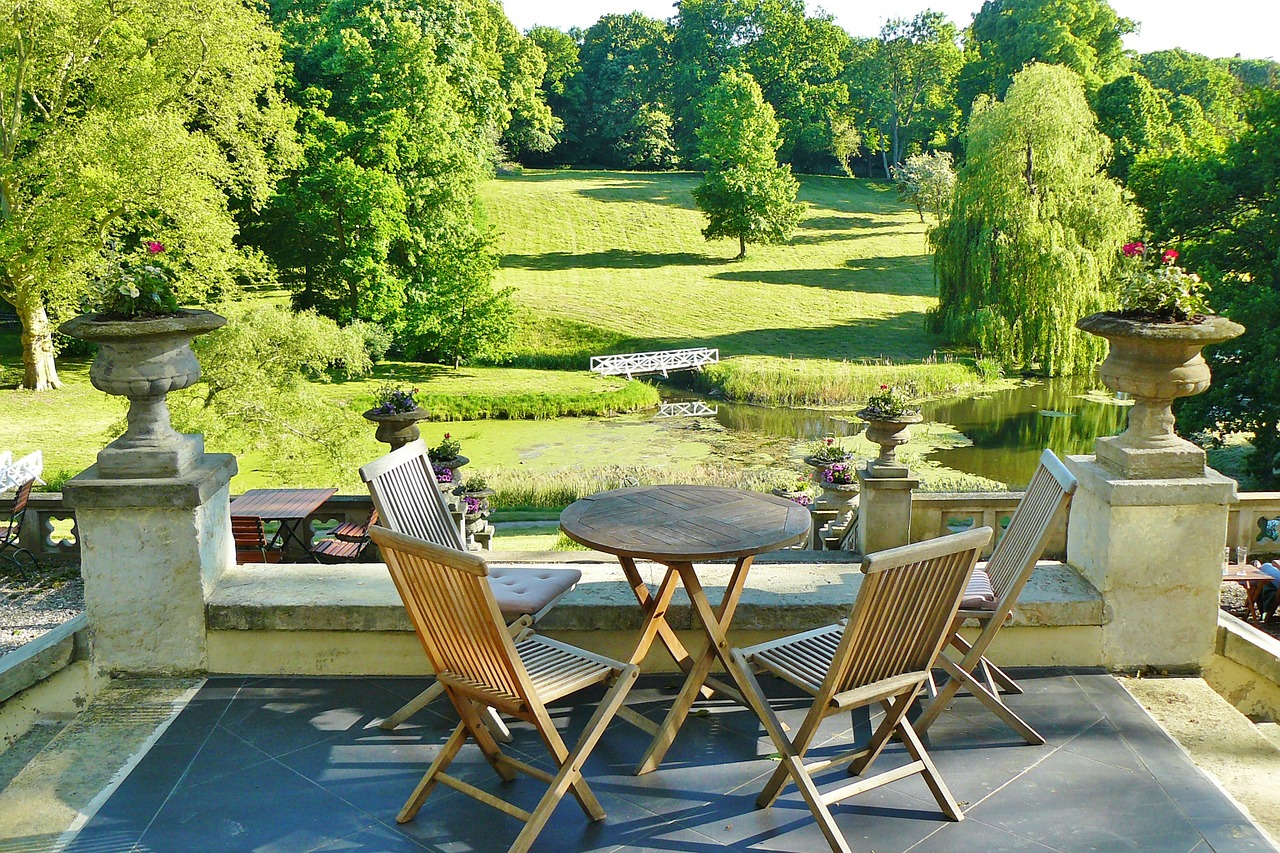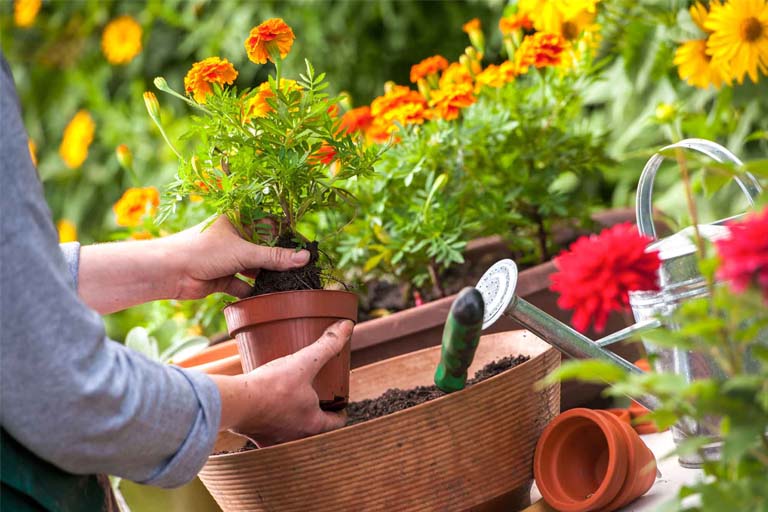You want your patio to stand out, to have that curb appeal that makes it pop. A patio garden is one way to accomplish this and distinguish your home from others on the block. Perrenials, herbs, or veggie gardens are easy to maintain and, done right, are mostly self-sustaining. If you have more time to dedicate to the craft, you can always mix in other, more elaborate, arrangements as well.
There are many approaches to take when starting your patio garden. Determining placement, weather extremes, your budget, and preventive care are some things to consider when starting your garden. Then there's the decision between vertical or horizontal gardens, and incorporating additional features like garden ornaments. The options are endless, even if you don't have much time, money, or energy to dedicate to gardening.
[amazon box= “B00DL9WSAC,B01JV40GSQ,B00TQ1F9DC” template=”table”]
Consider the Best Location for a Patio Garden
Location, location, location. It's not only important in real estate transactions. When setting up a patio garden, homeowners have to choose the perfect spot for their garden. Getting enough sunlight, water, and avoiding overly windy conditions are a few factors that'll play into the planting area.
Sunlight, temperature, and wind
Most people tend to overlook how many hours of daylight their patio gets during the day. Buildings, balconies, clouds, or any small obstruction can minimize direct sunlight to the area. And, when starting a patio garden, it's essential to ensure there are sufficient sunlight and heat in the area. It's also crucial to consider growing season. The sunlight moves differently in winter and summer months. So, it's vital to ensure the garden gets sufficient sunlight throughout the season. Too much heat can also be a bad thing. Some plants can't survive scorching temperatures. When choosing a garden location, factor this into the decision.
Some plants can't sustain themselves in the wind, while others thrive. In cold regions, or areas where snow is common, choosing the right assortments is also essential. The USDA hardiness zone is an excellent reference for determining which plants, herbs, and flowers can survive colder temperatures. Depending on weather conditions, not all plants can grow in specific zones. The hardiness guide provides insight as to which plants homeowners can place in their patio garden that'll survive.
Choosing the Right Plants for a Patio Garden
When preparing a patio garden, it's also important to consider the plants, flowers, veggies and herbs to grow. Some individuals want something simple, which requires minimum time dedication. Others want the most beautiful arrangements, regardless of price or how much time it is going to cost them. No matter which extreme you're in, there are several great, easy to care for plants for a patio garden.
Veggie garden
Herb garden
Flower garden
Soil and Fertilizers for the Patio Garden
Good soil and fertilizers go a long way in maintaining a patio garden. Especially when gardeners don't plan on dedicating much time to maintenance, the best fertilizers help with growth. The soil is the primary source of nutrients for the plants, veggies, and herbs in a garden. For this reason, it's essential to choose the best soil available. No matter how much sunlight or watering gardeners do, a poor quality soil will impede growth.
Loam soil is the best option for a patio garden. It contains nitrogen, phosphorous, and potassium, as well as other essential nutrients plants need. Plants continually draw nutrients from the soil. So, it's necessary to frequently tend to the land and refresh it when needed. Adding organic soil, mulch, and water regularly are some simple ways to help maintain the soil's health. It's also going to help the patio garden grow and flourish in otherwise poor growth conditions.
[amazon box= “B000OWF7YI,B017VN8XB6,B00192ANSW” template=”table”]
For those growing plants in containers, fertilizer is also imperative to help the patio garden nourish. Plants absorb nutrients through their leaves or roots. So, it's essential to choose a fertilizer which is easy to apply and will make direct contact with these areas. If plants aren't getting essential nutrients, they aren't going to grow.
A quality fertilizer, along with high-quality soil blends, will produce the best results in a patio garden.
Incorporate Vertical Patio Gardens in Tight Spaces
One of the main issues people face when setting up a patio garden is not having enough space. This issue, however, shouldn't be a hindrance. There are many ways to get around tight spaces when starting a garden. Vertical gardening is one such solution many homeowners turn to when starting a patio garden. As the name implies, vertical gardening is a process where gardeners grow plants vertically, rather than horizontally. Balconies in buildings or small patios are the perfect place to set up a vertical landscape.
There are many bases or frames that gardeners can utilize when setting up their vertical garden. Wire fencing, wooden panels, pallets, or purchasing upright containers are a few options to consider. Succulents and other types of foliage grow well in a vertical garden setting. Veggies that grow on vines also thrive in a vertical garden setup. Since they have room to flourish and roots aren't in the way, it's a preferred growth method for gardeners.
Hex wire or mesh panels are also great bases to incorporate into a vertical garden. They help preserve the upward growth direction and also help contain leaves or vines from growing wildly. Gardeners will find it's easier to prune, trim, cut, or otherwise maintain their garden using these items as well.
[amazon box= “B007TFTXAC,B076J79DSV,B077QR29GG” template=”table”]
Vertical gardens are also an excellent option for those who are creative when setting up a patio garden. Incorporating fun colors, planters, boxes, and frames create a distinct outdoor oasis. Gardeners can use plastic bottles, old boxes, or build their containers to grow plants in. They can incorporate several color schemes, or choose a simple pattern or arrangement. The options are endless.
When there isn't much space to work with, gardeners must be creative. The vertical garden is a great solution.
Patio Garden Maintenance
Garden maintenance is essential in any space. But this is especially true in smaller patio garden areas. The reason being is that things look messy when gardeners don't properly maintain them. In a small area, with dead flowers, overflowing soil, or weeds everywhere, the space doesn't look good. Proper maintenance will help preserve not only the appearance, but also viability, health, and longevity of the patio garden.
Some things gardeners will do when it comes to garden maintenance include:
Preventive care and maintenance aren't tricky, but it is something that gardeners must do. The more dedication people put into caring for a patio garden, the higher the growth results are. These are some simple steps every homeowner can take, that don't require much effort, to maintain a healthy garden.
Tools Necessary to Maintain a Patio Garden
Having the right tools when gardening makes life much more manageable than not having these items around. Whether it's a balcony garden, small container garden, or patio gardens, some tools are imperative for gardeners to own. Gloves might not seem important but help prevent splintering or injuries on sharp spines when working in the garden. Pruners are also one of the best gardening tools to own when maintaining a patio garden. They make it easy to cut off dead foliage or broken branches without damaging other flowers in the process.
Pesticides are necessary for some gardens also. Caterpillars and other small insects that make their way into veggies can wreak havoc. Most people don't want to touch these animals and, in some cases, it's dangerous to do so. A pesticide will help maintain the garden's health, preserve the plants, and avoid destruction. It also makes it easy to stop infestation (as a preventive tool) before it begins in the garden.
[amazon box= “B000DZH3XO,B076B4VJXQ,B01N9OGUSD” template=”table”]
Rakes, hoes, and spades are also some garden tools that some gardeners will use in a larger patio area. Edgers and weeders are also great tools to have handy when doing maintenance work around the garden. Outside some homes where they have to dig to add fertilizer or soil, these tools are beneficial. Most patio gardeners don't need the largest gardening tools to maintain the space. However, having the right arsenal of tools will enhance the gardening experience.
No matter how big or small a patio garden is, it's essential to maintain it to ensure it develops properly. These are some tools every gardener can use to help in the growth, maintenance, and preservation of their garden.
Maintaining a Healthy Patio Garden in Tight Spaces with Minimal Time
You don't need a 10-acre plot to come up with the perfect landscape design for your garden. Many homeowners make due with tiny spaces. Balconies, patios, and even a small corner in a kitchen is a viable location for a garden. That, of course, is as long as the gardener is willing to do the work to achieve the best results. When it comes to setting up a patio garden, there isn't much work that goes into the process. Even with a small space, you can do plenty and grow a magnificent outdoor oasis.
Incorporating the right mix of plants, veggies, and herb assortments is just the starting point. Understanding how to care for and preserve the garden is the other important aspect most gardeners tend to forget. With these simple steps, you'll design the perfect outdoor patio garden without having to spend much time or money to do so. These are some fun ideas to help you start the process of designing your garden. Taking these steps will allow you to develop a patio that stands apart from the neighbors'.





Leave a Reply